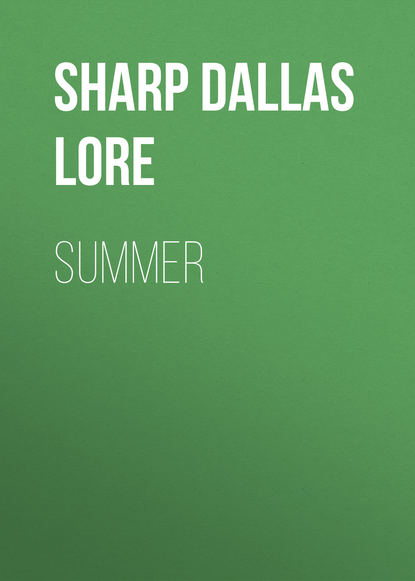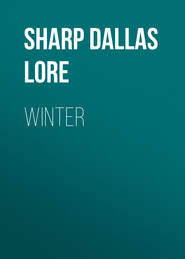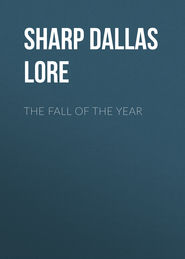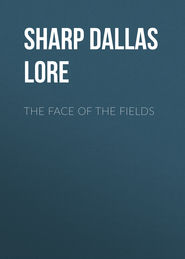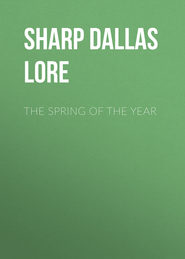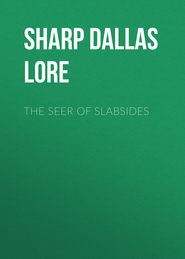По всем вопросам обращайтесь на: info@litportal.ru
(©) 2003-2024.
✖
Summer
Настройки чтения
Размер шрифта
Высота строк
Поля
Play seems to be as natural and as necessary to the wild animals as it is to human beings. Like us the animals play hardest while young, but as some human children never outgrow their youth and love of play, so there are old animals that never grow too fat nor too stiff nor too stupid to play.
The condition of the body has a great deal to do with the state of the spirit. The sleek, lithe otter could not possibly grow fat. He keeps in trim because he cannot help it, perhaps, but however that may be, he is a very boy for play, and even goes so far as to build himself a slide or chute for the fun of diving down it into the water. A writer in one of the magazines tells of an otter in the New York Zoölogical Park that swam and dived with a round stone balanced on his head.
Building a slide is more than we children used to do, for we had ready-made for us grandfather’s two big slanting cellar-doors, down which we slid and slid and slid till the wood was scoured white and slippery with the sliding. The otter loves to slide. Up he climbs on the bank, then down he goes – splash – into the stream. Up he climbs and down he goes – time after time, day after day. There is nothing like a slide, unless it is a cellar-door.
How much of a necessity to the otter is his play, one would like to know – what he would give up for it, and how he would do deprived of it. In the case of Pups, my neighbor’s beautiful young collie, play seems more needful than food. There are no children, no one, to play with him there, so that the sight of my small boys sets him almost frantic.
His efforts to induce a hen or a rooster to play with him are pathetic. The hen cannot understand. She hasn’t a particle of play in her anyhow, but Pups cannot get that through his head. He runs rapidly around her, drops on all fours flat, swings his tail, cocks his ears, looks appealingly and barks a few little cackle-barks, as nearly hen-like as he can bark them, then dashes off and whirls back – while the hen picks up another bug. She never sees Pups. The old white coon cat is better; but she is usually up the miff-tree. Pups steps on her, knocks her over, or otherwise offends, especially when he tags her out into the fields and spoils her hunting. The Society for the Prevention of Cruelty to Animals ought to send some child or puppy out to play with Pups of a Saturday.
I doubt if among the lower forms of animals play holds any such prominent place as with the dog and the keen-witted, intelligent otter. To catch these lower animals at play is a rare experience. One of our naturalists describes the game of “follow my leader,” as he watched it played by a school of minnows – a most unusual record, but not at all hard to believe, for I saw recently, from the bridge in the Boston Public Garden, a school of goldfish playing at something very much like it.
This naturalist was lying stretched out upon an old bridge, watching the minnows through a large crack between the planks, when he saw one leap out of the water over a small twig floating at the surface. Instantly another minnow broke the water and flipped over the twig, followed by another and another, the whole school, as so many sheep, or so many children, following the leader over the twig.
The love of play seems to be one of the elemental needs of all life above the plants, and the games of us human children seem to have been played before the dry land was, when there were only water babies in the world, for certainly the fish never learned “follow my leader” from us. Nor did my young bees learn from us their game of “prisoners’ base” which they play almost every summer noontime in front of the hives. And what is the game the flies play about the cord of the drop-light in the centre of the kitchen ceiling?
One of the most interesting animal games that I ever saw was played by a flock of butterflies on the very top of Mount Hood, whose pointed snow-piled peak looks down from the clouds over the whole vast State of Oregon.
Mount Hood is an ancient volcano, eleven thousand two hundred twenty-five feet high. Some seven thousand feet or more up, we came to “Tie-up Rock” – the place on the climb where the glacier snows lay before us and we were tied up to one another and all of us fastened by rope to the guide.
From this point to the peak, it was sheer deep snow. For the last eighteen hundred feet we clung to a rope that was anchored on the edge of the crater at the summit, and cut our steps as we climbed.
Once we had gained the peak, we lay down behind a pile of sulphurous rock, out of the way of the cutting wind, and watched the steam float up from the crater, with the widest world in view that I ever turned my eyes upon.
The draft pulled hard about the openings among the rock-piles, but hardest up a flue, or chimney, that was left in the edge of the crater-rim where parts of the rock had fallen away.
As we lay at the side of this flue, we soon discovered that butterflies were hovering about us; no, not hovering, but flying swiftly up between the rocks from somewhere down the flue. I could scarcely believe my eyes. What could any living thing be doing here? – and of all things, butterflies? This was three or four thousand feet above the last vestige of vegetation, a mere point of volcanic rock (the jagged edge-piece of an old crater) wrapped in eternal ice and snow, with sulphurous gases pouring over it, and across it blowing a wind that would freeze as soon as the sun was out of the sky.
But here were real butterflies. I caught two or three of them and found them to be vanessas (Vanessa californica), a close relative of our mourning-cloak butterfly. They were all of one species, apparently, but what were they doing here?
Scrambling to the top of the piece of rock behind which I had been resting, I saw that the peak was alive with butterflies, and that they were flying – over my head, out down over the crater, and out of sight behind the peak, whence they reappeared, whirling up the flue past me on the wings of the draft that pulled hard through it, to sail down over the crater again, and again to be caught by the draft and pulled up the flue, to their evident delight, up and out over the peak, where they could again take wings, as boys take their sleds, and so down again for the fierce upward draft that bore them whirling over Mount Hood’s pointed peak.
Here they were, thousands of feet above the snow-line, where there was no sign of vegetation, where the heavy vapors made the air to smell, where the very next day a wild snowstorm wrapped its frozen folds about the peak – here they were, butterflies, playing, a host of them, like so many schoolboys on the first coasting snow!
CHAPTER III
A CHAPTER OF THINGS TO SEE THIS SUMMER
I
The dawn, the breaking dawn! I know nothing lovelier, nothing fresher, nothing newer, purer, sweeter than a summer dawn. I am just back from one – from the woods and cornfields wet with dew, the meadows and streams white with mist, and all the world of paths and fences running off into luring spaces of wavering, lifting, beckoning horizons where shrouded forms were moving and hidden voices calling. By noontime the buzz-saw of the cicada will be ripping the dried old stick of this August day into splinters and sawdust. No one could imagine that this midsummer noon at 90° in the shade could have had so Maylike a beginning.
II
I said in “The Spring of the Year” that you should see a farmer ploughing, then a few weeks later the field of sprouting corn. Now in July or August you must see that field in silk and tassel, blade and stalk standing high over your head.
You might catch the same sight of wealth in a cotton-field, if cotton is “king” in your section; or in a vast wheat-field, if wheat is your king; or in a potato-field if you live in Maine – but no, not in a potato-field. It is all underground in a potato-field. Nor can cotton in the South, or wheat in the Northwest, give you quite the depth and the ranked and ordered wealth of long, straight lines of tall corn.
Then to hear a summer rain sweep down upon it and the summer wind run swiftly through it! You must see a great field of standing corn.
III
Keep out from under all trees, stand away from all tall poles, but get somewhere in the open and watch a blue-black thunderstorm come up. It is one of the wonders of summer, one of the shows of the sky, a thing of terrible beauty that I must confess I cannot look at without dread and a feeling of awe that rests like a load upon me.
“All heaven and earth are still – though not in sleep,
But breathless, as we grow when feeling most;
And silent, as we stand in thoughts too deep: —
·······
The sky is changed! – and such a change! Oh night,
And storm, and darkness, ye are wondrous strong,
Yet lovely in your strength······
········· Far along,
From peak to peak the rattling crags among,
Leaps the live thunder! Not from one lone cloud,
But every mountain now hath found a tongue,
And Jura answers, through her misty shroud,
Back to the joyous Alps who call to her aloud.”
IV
But there are many smaller, individual things to be seen this summer, and among them, notable for many reasons, is a hummingbird’s nest. “When completed it is scarcely larger than an English walnut and is usually saddled on a small horizontal limb of a tree or shrub frequently many feet from the ground. It is composed almost entirely of soft plant fibers, fragments of spiders’ webs sometimes being used to hold them in shape. The sides are thickly studded with bits of lichen, and practiced, indeed, is the eye of the man who can distinguish it from a knot on the limb.”
This is the smallest of birds’ nests and quite as rare and difficult to find as any single thing that you can go out to look for. You will stumble upon one now and then; but not many in a whole lifetime. Let it be a test of your keen eye – this finding of a little hummer’s nest with its two white eggs the size of small pea-beans or its two tiny young that are up and off on their marvelous wings within three weeks from the time the eggs are laid!
V
Have you read Mr. William L. Finley’s story of the California condor’s nest? The hummingbird young is out and gone within three weeks; but the condor young is still in the care of its watchful parents three months after it is hatched. You ought to watch the slow, guarded youth of one of the larger hawks or owls during the summer. Such birds build very early, – before the snow is gone sometimes, – but they are to be seen feeding their young far into the summer. The wide variety in bird-life, both in size and habits, will be made very plain to you if you will watch the nests of two such birds as the hummer and the vulture or the eagle.
VI
This is the season of flowers. But what among them should you especially see? Some time ago one of the school-teachers near me brought in a list of a dozen species of wild orchids, gathered out of the meadows, bogs, and woods about the neighborhood. Can you do as well?
Suppose, then, that you try to find as many. They were the pink lady’s-slipper; the yellow lady’s-slipper; the yellow fringed-orchis (Habenaria ciliaris); the ladies’-tresses, two species; the rattlesnake-plantain; arethusa, or Indian pink; calopogon, or grass pink; pogonia, or snake-mouth (ophioglossoides and verticillata); the ragged fringed-orchis; and the showy or spring orchis. Arethusa and the showy orchis really belong to the spring but the others will be task enough for you, and one that will give point and purpose to your wanderings afield this summer.
VII
There are a certain number of moths and butterflies that you should see and know also. If one could come to know, say, one hundred and fifty flowers and the moths and butterflies that visit them (for the flower and its insect pollen-carrier are to be thought of and studied together), one would have an excellent speaking acquaintance with the blossoming out-of-doors.
Now, among the butterflies you ought to know the mourning-cloak, or vanessa; the big red-brown milkweed butterfly; the big yellow tiger swallowtail; the small yellow cabbage butterfly; the painted beauty; the red admiral; the common fritillary; the common wood-nymph – but I have named enough for this summer, in spite of the fact that I have not named the green-clouded or Troilus butterfly, and Asterias, the black swallowtail, and the red-spotted purple, and the viceroy.
Among the moths to see are the splendid Promethea, Cecropia, bullseye, Polyphemus, and Luna, to say nothing of the hummingbird moth, and the sphinx, or hawk, moths, especially the large one that feeds as a caterpillar upon the tomato-vines, Ma-cros’-i-la-quin-que-mac-u-la’-ta.
VIII
There is a like list of interesting beetles and other insects, that play a large part in even your affairs, which you ought to watch during the summer: the honeybee, the big droning golden bumblebee, the large white-faced hornet that builds the paper nests in the bushes and trees, the gall-flies, the ichneumon-flies, the burying beetle, the tumble-bug beetle, the dragon-fly, the caddis-fly – these are only a few of a whole world of insect folk about you, whose habits and life-histories are of utmost importance and of tremendous interest. You will certainly believe it if you will read the Peckhams’ book called “Wasps, Social and Solitary,” or the beautiful and fascinating insect stories by the great French entomologist Fabre. Get also “Every-day Butterflies,” by Scudder; and “Moths and Butterflies,” by Miss Dickerson, and “Insect Life,” by Kellogg.
IX
You see I cannot stop with this list of the things. That is the trouble with summer – there is too much of it while it lasts, too much variety and abundance of life. One is simply compelled to limit one’s self to some particular study, and to pick up mere scraps from other fields.
The condition of the body has a great deal to do with the state of the spirit. The sleek, lithe otter could not possibly grow fat. He keeps in trim because he cannot help it, perhaps, but however that may be, he is a very boy for play, and even goes so far as to build himself a slide or chute for the fun of diving down it into the water. A writer in one of the magazines tells of an otter in the New York Zoölogical Park that swam and dived with a round stone balanced on his head.
Building a slide is more than we children used to do, for we had ready-made for us grandfather’s two big slanting cellar-doors, down which we slid and slid and slid till the wood was scoured white and slippery with the sliding. The otter loves to slide. Up he climbs on the bank, then down he goes – splash – into the stream. Up he climbs and down he goes – time after time, day after day. There is nothing like a slide, unless it is a cellar-door.
How much of a necessity to the otter is his play, one would like to know – what he would give up for it, and how he would do deprived of it. In the case of Pups, my neighbor’s beautiful young collie, play seems more needful than food. There are no children, no one, to play with him there, so that the sight of my small boys sets him almost frantic.
His efforts to induce a hen or a rooster to play with him are pathetic. The hen cannot understand. She hasn’t a particle of play in her anyhow, but Pups cannot get that through his head. He runs rapidly around her, drops on all fours flat, swings his tail, cocks his ears, looks appealingly and barks a few little cackle-barks, as nearly hen-like as he can bark them, then dashes off and whirls back – while the hen picks up another bug. She never sees Pups. The old white coon cat is better; but she is usually up the miff-tree. Pups steps on her, knocks her over, or otherwise offends, especially when he tags her out into the fields and spoils her hunting. The Society for the Prevention of Cruelty to Animals ought to send some child or puppy out to play with Pups of a Saturday.
I doubt if among the lower forms of animals play holds any such prominent place as with the dog and the keen-witted, intelligent otter. To catch these lower animals at play is a rare experience. One of our naturalists describes the game of “follow my leader,” as he watched it played by a school of minnows – a most unusual record, but not at all hard to believe, for I saw recently, from the bridge in the Boston Public Garden, a school of goldfish playing at something very much like it.
This naturalist was lying stretched out upon an old bridge, watching the minnows through a large crack between the planks, when he saw one leap out of the water over a small twig floating at the surface. Instantly another minnow broke the water and flipped over the twig, followed by another and another, the whole school, as so many sheep, or so many children, following the leader over the twig.
The love of play seems to be one of the elemental needs of all life above the plants, and the games of us human children seem to have been played before the dry land was, when there were only water babies in the world, for certainly the fish never learned “follow my leader” from us. Nor did my young bees learn from us their game of “prisoners’ base” which they play almost every summer noontime in front of the hives. And what is the game the flies play about the cord of the drop-light in the centre of the kitchen ceiling?
One of the most interesting animal games that I ever saw was played by a flock of butterflies on the very top of Mount Hood, whose pointed snow-piled peak looks down from the clouds over the whole vast State of Oregon.
Mount Hood is an ancient volcano, eleven thousand two hundred twenty-five feet high. Some seven thousand feet or more up, we came to “Tie-up Rock” – the place on the climb where the glacier snows lay before us and we were tied up to one another and all of us fastened by rope to the guide.
From this point to the peak, it was sheer deep snow. For the last eighteen hundred feet we clung to a rope that was anchored on the edge of the crater at the summit, and cut our steps as we climbed.
Once we had gained the peak, we lay down behind a pile of sulphurous rock, out of the way of the cutting wind, and watched the steam float up from the crater, with the widest world in view that I ever turned my eyes upon.
The draft pulled hard about the openings among the rock-piles, but hardest up a flue, or chimney, that was left in the edge of the crater-rim where parts of the rock had fallen away.
As we lay at the side of this flue, we soon discovered that butterflies were hovering about us; no, not hovering, but flying swiftly up between the rocks from somewhere down the flue. I could scarcely believe my eyes. What could any living thing be doing here? – and of all things, butterflies? This was three or four thousand feet above the last vestige of vegetation, a mere point of volcanic rock (the jagged edge-piece of an old crater) wrapped in eternal ice and snow, with sulphurous gases pouring over it, and across it blowing a wind that would freeze as soon as the sun was out of the sky.
But here were real butterflies. I caught two or three of them and found them to be vanessas (Vanessa californica), a close relative of our mourning-cloak butterfly. They were all of one species, apparently, but what were they doing here?
Scrambling to the top of the piece of rock behind which I had been resting, I saw that the peak was alive with butterflies, and that they were flying – over my head, out down over the crater, and out of sight behind the peak, whence they reappeared, whirling up the flue past me on the wings of the draft that pulled hard through it, to sail down over the crater again, and again to be caught by the draft and pulled up the flue, to their evident delight, up and out over the peak, where they could again take wings, as boys take their sleds, and so down again for the fierce upward draft that bore them whirling over Mount Hood’s pointed peak.
Here they were, thousands of feet above the snow-line, where there was no sign of vegetation, where the heavy vapors made the air to smell, where the very next day a wild snowstorm wrapped its frozen folds about the peak – here they were, butterflies, playing, a host of them, like so many schoolboys on the first coasting snow!
CHAPTER III
A CHAPTER OF THINGS TO SEE THIS SUMMER
I
The dawn, the breaking dawn! I know nothing lovelier, nothing fresher, nothing newer, purer, sweeter than a summer dawn. I am just back from one – from the woods and cornfields wet with dew, the meadows and streams white with mist, and all the world of paths and fences running off into luring spaces of wavering, lifting, beckoning horizons where shrouded forms were moving and hidden voices calling. By noontime the buzz-saw of the cicada will be ripping the dried old stick of this August day into splinters and sawdust. No one could imagine that this midsummer noon at 90° in the shade could have had so Maylike a beginning.
II
I said in “The Spring of the Year” that you should see a farmer ploughing, then a few weeks later the field of sprouting corn. Now in July or August you must see that field in silk and tassel, blade and stalk standing high over your head.
You might catch the same sight of wealth in a cotton-field, if cotton is “king” in your section; or in a vast wheat-field, if wheat is your king; or in a potato-field if you live in Maine – but no, not in a potato-field. It is all underground in a potato-field. Nor can cotton in the South, or wheat in the Northwest, give you quite the depth and the ranked and ordered wealth of long, straight lines of tall corn.
Then to hear a summer rain sweep down upon it and the summer wind run swiftly through it! You must see a great field of standing corn.
III
Keep out from under all trees, stand away from all tall poles, but get somewhere in the open and watch a blue-black thunderstorm come up. It is one of the wonders of summer, one of the shows of the sky, a thing of terrible beauty that I must confess I cannot look at without dread and a feeling of awe that rests like a load upon me.
“All heaven and earth are still – though not in sleep,
But breathless, as we grow when feeling most;
And silent, as we stand in thoughts too deep: —
·······
The sky is changed! – and such a change! Oh night,
And storm, and darkness, ye are wondrous strong,
Yet lovely in your strength······
········· Far along,
From peak to peak the rattling crags among,
Leaps the live thunder! Not from one lone cloud,
But every mountain now hath found a tongue,
And Jura answers, through her misty shroud,
Back to the joyous Alps who call to her aloud.”
IV
But there are many smaller, individual things to be seen this summer, and among them, notable for many reasons, is a hummingbird’s nest. “When completed it is scarcely larger than an English walnut and is usually saddled on a small horizontal limb of a tree or shrub frequently many feet from the ground. It is composed almost entirely of soft plant fibers, fragments of spiders’ webs sometimes being used to hold them in shape. The sides are thickly studded with bits of lichen, and practiced, indeed, is the eye of the man who can distinguish it from a knot on the limb.”
This is the smallest of birds’ nests and quite as rare and difficult to find as any single thing that you can go out to look for. You will stumble upon one now and then; but not many in a whole lifetime. Let it be a test of your keen eye – this finding of a little hummer’s nest with its two white eggs the size of small pea-beans or its two tiny young that are up and off on their marvelous wings within three weeks from the time the eggs are laid!
V
Have you read Mr. William L. Finley’s story of the California condor’s nest? The hummingbird young is out and gone within three weeks; but the condor young is still in the care of its watchful parents three months after it is hatched. You ought to watch the slow, guarded youth of one of the larger hawks or owls during the summer. Such birds build very early, – before the snow is gone sometimes, – but they are to be seen feeding their young far into the summer. The wide variety in bird-life, both in size and habits, will be made very plain to you if you will watch the nests of two such birds as the hummer and the vulture or the eagle.
VI
This is the season of flowers. But what among them should you especially see? Some time ago one of the school-teachers near me brought in a list of a dozen species of wild orchids, gathered out of the meadows, bogs, and woods about the neighborhood. Can you do as well?
Suppose, then, that you try to find as many. They were the pink lady’s-slipper; the yellow lady’s-slipper; the yellow fringed-orchis (Habenaria ciliaris); the ladies’-tresses, two species; the rattlesnake-plantain; arethusa, or Indian pink; calopogon, or grass pink; pogonia, or snake-mouth (ophioglossoides and verticillata); the ragged fringed-orchis; and the showy or spring orchis. Arethusa and the showy orchis really belong to the spring but the others will be task enough for you, and one that will give point and purpose to your wanderings afield this summer.
VII
There are a certain number of moths and butterflies that you should see and know also. If one could come to know, say, one hundred and fifty flowers and the moths and butterflies that visit them (for the flower and its insect pollen-carrier are to be thought of and studied together), one would have an excellent speaking acquaintance with the blossoming out-of-doors.
Now, among the butterflies you ought to know the mourning-cloak, or vanessa; the big red-brown milkweed butterfly; the big yellow tiger swallowtail; the small yellow cabbage butterfly; the painted beauty; the red admiral; the common fritillary; the common wood-nymph – but I have named enough for this summer, in spite of the fact that I have not named the green-clouded or Troilus butterfly, and Asterias, the black swallowtail, and the red-spotted purple, and the viceroy.
Among the moths to see are the splendid Promethea, Cecropia, bullseye, Polyphemus, and Luna, to say nothing of the hummingbird moth, and the sphinx, or hawk, moths, especially the large one that feeds as a caterpillar upon the tomato-vines, Ma-cros’-i-la-quin-que-mac-u-la’-ta.
VIII
There is a like list of interesting beetles and other insects, that play a large part in even your affairs, which you ought to watch during the summer: the honeybee, the big droning golden bumblebee, the large white-faced hornet that builds the paper nests in the bushes and trees, the gall-flies, the ichneumon-flies, the burying beetle, the tumble-bug beetle, the dragon-fly, the caddis-fly – these are only a few of a whole world of insect folk about you, whose habits and life-histories are of utmost importance and of tremendous interest. You will certainly believe it if you will read the Peckhams’ book called “Wasps, Social and Solitary,” or the beautiful and fascinating insect stories by the great French entomologist Fabre. Get also “Every-day Butterflies,” by Scudder; and “Moths and Butterflies,” by Miss Dickerson, and “Insect Life,” by Kellogg.
IX
You see I cannot stop with this list of the things. That is the trouble with summer – there is too much of it while it lasts, too much variety and abundance of life. One is simply compelled to limit one’s self to some particular study, and to pick up mere scraps from other fields.





